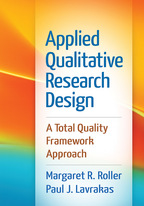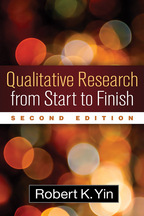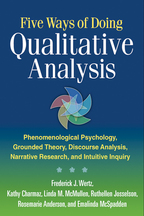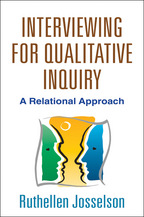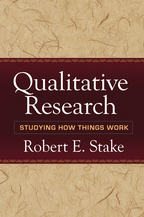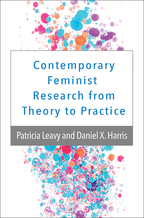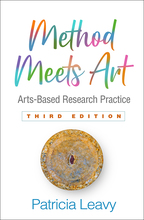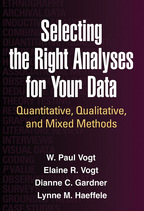Applied Qualitative Research Design
A Total Quality Framework Approach
Margaret R. Roller and Paul J. Lavrakas
HardcoverPaperbacke-bookprint + e-book
Hardcover
orderJanuary 29, 2015
ISBN 9781462519088
Price: $101.00 398 Pages
Size: 7" x 10"
Paperback
orderJanuary 30, 2015
ISBN 9781462515752
Price: $67.00398 Pages
Size: 7" x 10"
“Roller and Lavrakas do a fantastic job of identifying strengths and limitations of each design model.”

—The Qualitative Report
“This book is suffused with the elements of what the authors call the total quality framework—namely credibility, analyzability, transparency, and usefulness. Each chapter is built around this framework so the important decisions needed throughout the stages of a qualitative research study are covered….Good use is made of chapter summaries and discussion topics and worked examples….Where appropriate, the advantages and disadvantages of preparing for, collecting, and analyzing data using technology is explored providing an additional dimension to the text. I would recommend this book to educators, researchers, and postgraduate students who are undertaking qualitative research.”

—Nurse Researcher
“A hands-on, innovative, integrated methods text….The framework provides principles and practices for researchers to apply throughout the research process so that they are more likely to gather high-quality data, come to a more complete and valid interpretation of their data, and generate and present useful outcomes….The book contains chapters on each of the main qualitative methods: in-depth interviews, focus groups, ethnography, content analysis, and case studies. The authors, in keeping with the integrated approach of their model, in parallel fashion apply each of the four elements of the framework to each technique and its particular requirements. This feature alone is a major strength of this work. But each method chapter contains some additional valuable elements, such as skills researchers must bring to that particular technique, strengths and weaknesses of that approach, and ethical considerations. The authors also provide a case study at the end of each chapter that is an example of a research project utilizing the TQF standards for that specific method. If that weren’t enough, the final chapter focuses on how to use the TQF to assess the quality of qualitative studies done by others—or at least, grant or project proposals….The book itself is very well organized and well written….Section headings and parallel organization make it easy to jump back and forth, and chapter summaries along with an extensive glossary likewise aid the reader….Overall, Roller and Lavrakas have done social science scholars of all stripes a big favor.”

—Public Opinion Quarterly
“Readers will benefit from the book’s organization, with its similarly formatted chapters, and from the frequent examples, bulleted lists, diagrams, and annotated bibliographies at the end of the chapters. The overall presentation facilitates comprehension of what can be, for some, difficult content….This is an outstanding adjunctive resource for those using particular research paradigms (e.g., grounded theory, phenomenology, ethnography, etc.) and for those in need of a framework to ensure rigor in any qualitative research study. The book provides a new, fresh, and meticulous approach to creating, understanding, using, and evaluating qualitative research.”

—Doody's Review Service (review by Martha M. Scheckel, PhD, RN)
“The presentation of a TQF that can be used both to evaluate published studies and create high-quality studies is a unique contribution to the field of qualitative inquiry. The TQF will be particularly helpful to graduate students who are venturing into qualitative research. The authors skillfully guide the reader through the various modes of data collection and analysis. They provide detailed guidance on key methodological issues, such as decisions regarding sample size, conducting telephone versus face-to-face interviews, and uses of focus groups.”

—Margaret J. Bull, PhD, RN, Marquette University College of Nursing
“A most original contribution that has been put together with the greatest of care. I applaud the authors for dividing each of the five methods chapters into well-organized sections that cover all aspects of the methods and explain how and why to apply TQF principles. Each chapter ends with an exceptionally effective case study to illustrate the concepts described. Other highlights of the book include the discussion topics and exercises to further readers’ thinking and understanding. This will be a great text for my senior-level honors seminar in qualitative research design.”

—Kimberley Ducey, PhD, Department of Sociology, University of Winnipeg, Canada
“This is an excellent text for a graduate qualitative research course, as well as a valuable reference for professionals. Well-written and easy to use, it provides a practical approach for students by incorporating exercises, case studies, web resources, and discussion topics. The latest research trends are discussed throughout, such as email IDIs, mobile ethnography, and synchronous versus asynchronous online discussion boards. The authors’ years of experience in conducting qualitative research make this book not only informative, but interesting to read.”

—Candice R. Hollenbeck, PhD, Department of Marketing, University of Georgia
“A much-needed, pathbreaking book that will help set new standards of authoritativeness and excellence in qualitative research. The TQF is a powerful approach that can inform all types of research. I particularly like the authors' thorough attention to context, which they carefully explain in the introduction and develop throughout the book; this is one of the most important aspects of qualitative research.”

—Gerald Kosicki, PhD, School of Communication, The Ohio State University
“The writing is clear with helpful illustrative examples. Strengths of the book include its user-friendly narrative language and the effective applied exercises and case studies at the end of each chapter.”

—Mary I. Dereshiwsky, PhD, Department of Educational Leadership, Northern Arizona University
—The Qualitative Report
“This book is suffused with the elements of what the authors call the total quality framework—namely credibility, analyzability, transparency, and usefulness. Each chapter is built around this framework so the important decisions needed throughout the stages of a qualitative research study are covered….Good use is made of chapter summaries and discussion topics and worked examples….Where appropriate, the advantages and disadvantages of preparing for, collecting, and analyzing data using technology is explored providing an additional dimension to the text. I would recommend this book to educators, researchers, and postgraduate students who are undertaking qualitative research.”
—Nurse Researcher
“A hands-on, innovative, integrated methods text….The framework provides principles and practices for researchers to apply throughout the research process so that they are more likely to gather high-quality data, come to a more complete and valid interpretation of their data, and generate and present useful outcomes….The book contains chapters on each of the main qualitative methods: in-depth interviews, focus groups, ethnography, content analysis, and case studies. The authors, in keeping with the integrated approach of their model, in parallel fashion apply each of the four elements of the framework to each technique and its particular requirements. This feature alone is a major strength of this work. But each method chapter contains some additional valuable elements, such as skills researchers must bring to that particular technique, strengths and weaknesses of that approach, and ethical considerations. The authors also provide a case study at the end of each chapter that is an example of a research project utilizing the TQF standards for that specific method. If that weren’t enough, the final chapter focuses on how to use the TQF to assess the quality of qualitative studies done by others—or at least, grant or project proposals….The book itself is very well organized and well written….Section headings and parallel organization make it easy to jump back and forth, and chapter summaries along with an extensive glossary likewise aid the reader….Overall, Roller and Lavrakas have done social science scholars of all stripes a big favor.”
—Public Opinion Quarterly
“Readers will benefit from the book’s organization, with its similarly formatted chapters, and from the frequent examples, bulleted lists, diagrams, and annotated bibliographies at the end of the chapters. The overall presentation facilitates comprehension of what can be, for some, difficult content….This is an outstanding adjunctive resource for those using particular research paradigms (e.g., grounded theory, phenomenology, ethnography, etc.) and for those in need of a framework to ensure rigor in any qualitative research study. The book provides a new, fresh, and meticulous approach to creating, understanding, using, and evaluating qualitative research.”
—Doody's Review Service (review by Martha M. Scheckel, PhD, RN)
“The presentation of a TQF that can be used both to evaluate published studies and create high-quality studies is a unique contribution to the field of qualitative inquiry. The TQF will be particularly helpful to graduate students who are venturing into qualitative research. The authors skillfully guide the reader through the various modes of data collection and analysis. They provide detailed guidance on key methodological issues, such as decisions regarding sample size, conducting telephone versus face-to-face interviews, and uses of focus groups.”
—Margaret J. Bull, PhD, RN, Marquette University College of Nursing
“A most original contribution that has been put together with the greatest of care. I applaud the authors for dividing each of the five methods chapters into well-organized sections that cover all aspects of the methods and explain how and why to apply TQF principles. Each chapter ends with an exceptionally effective case study to illustrate the concepts described. Other highlights of the book include the discussion topics and exercises to further readers’ thinking and understanding. This will be a great text for my senior-level honors seminar in qualitative research design.”
—Kimberley Ducey, PhD, Department of Sociology, University of Winnipeg, Canada
“This is an excellent text for a graduate qualitative research course, as well as a valuable reference for professionals. Well-written and easy to use, it provides a practical approach for students by incorporating exercises, case studies, web resources, and discussion topics. The latest research trends are discussed throughout, such as email IDIs, mobile ethnography, and synchronous versus asynchronous online discussion boards. The authors’ years of experience in conducting qualitative research make this book not only informative, but interesting to read.”
—Candice R. Hollenbeck, PhD, Department of Marketing, University of Georgia
“A much-needed, pathbreaking book that will help set new standards of authoritativeness and excellence in qualitative research. The TQF is a powerful approach that can inform all types of research. I particularly like the authors' thorough attention to context, which they carefully explain in the introduction and develop throughout the book; this is one of the most important aspects of qualitative research.”
—Gerald Kosicki, PhD, School of Communication, The Ohio State University
“The writing is clear with helpful illustrative examples. Strengths of the book include its user-friendly narrative language and the effective applied exercises and case studies at the end of each chapter.”
—Mary I. Dereshiwsky, PhD, Department of Educational Leadership, Northern Arizona University

